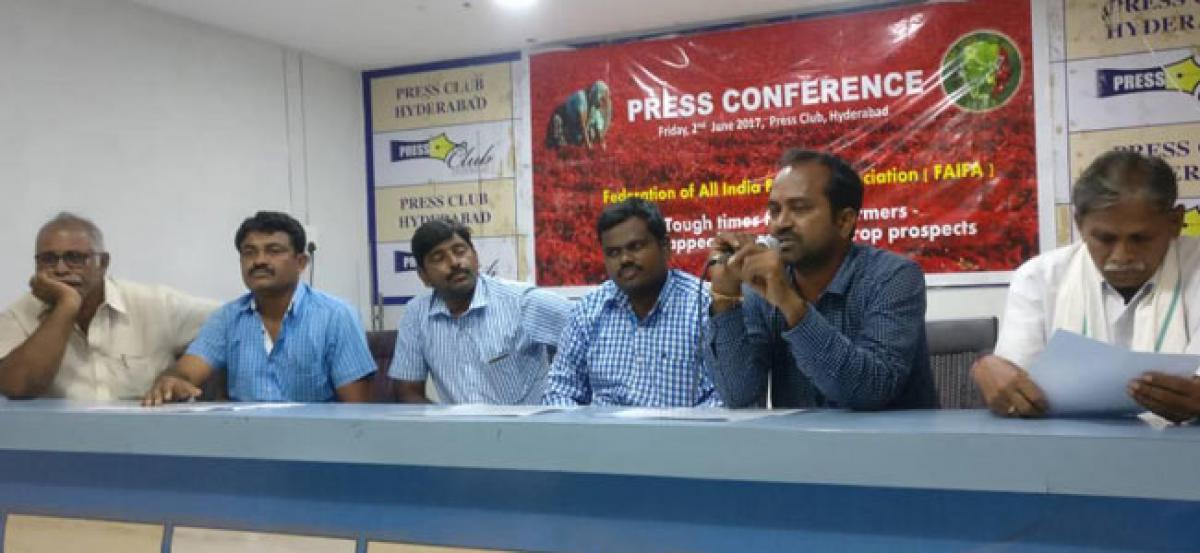Live
- Allu Arjun's Family Appearance on Unstoppable with NBK Breaks Viewership Records
- Unity of hearts & minds essential for peace & progress, says J&K Lt Governor
- IPL 2025 Auction: I deserve Rs 18 cr price, says Chahal on being acquired by Punjab Kings
- EAM Jaishankar inaugurates new premises of Indian embassy in Rome
- Sailing vessel INSV Tarini embarks on second leg of expedition to New Zealand
- Over 15,000 people affected by rain-related disasters in Sri Lanka
- IPL 2025 Auction: RCB acquire Hazlewood for Rs 12.50 cr; Gujarat Titans bag Prasidh Krishna at Rs 9.5 crore
- Maharashtra result reflects the outcome of Congress' destructive politics: BJP's Shazia Ilmi
- 13 killed, 18 injured as landslides, flash floods hit Indonesia's North Sumatra province
- Israeli PM seeks additional delay of testimony in court for criminal trial
Just In
FAIFA appeals for policy reforms to extricate chilli farmers from distress


Federation of All India Farmer Associations (FAIFA), a non-profit organization representing the cause of millions of farmers and farm workers of commercial crops across the States of Andhra Pradesh, Telangana, Karnataka, Gujarat etc.
Federation of All India Farmer Associations (FAIFA), a non-profit organization representing the cause of millions of farmers and farm workers of commercial crops across the States of Andhra Pradesh, Telangana, Karnataka, Gujarat etc.
appealed to the Union Minister for Agriculture and Farmers Welfare, Radhamohan Singh, to protect the interests of Indian chilli farmers by bringing in policy reforms and make chilli crop sustainable.
The appeal has also been submitted by FAIFA to Telangana Agriculture Minister Pocharam Srinivasa Reddy, and Agriculture Minister of Andhra Pradesh Somireddy Chandramohan Reddy. The farmers’ are also planning to meet the concerned policy makers in person to further represent their struggles.
India approx. contributes to 25% of the world's chilli requirement and is a leader in chilli exports followed by China with 24%. The crop plays a significant role in Indian economy by providing employment to millions of people at various levels including farmers and farm labourers.
However, the farmers engaged in cultivation of chilli are distressed due to declining exports, instability in prices, lack of sufficient cold storage facilities and the producers not getting due encouragement from the Government of India.
In India, major chilli producing states are Andhra Pradesh, Telangana, Orissa, Maharashtra, West Bengal, Karnataka, Rajasthan and Tamil Nadu.
Andhra Pradesh and Telangana contributes to 55% of the total chilli production with 20% of the area under cultivation. Poor performance of alternate crops and very lucrative chilli prices in 2016 led to an increase in the area under cultivation by 45% in 2017.
However, the prices have dropped by 60% from Rs 140/- per kg in 2016 to 35-40/- per kg in 2017. Lack of minimum support prices and insufficient storage facilities have left farmers with no option but to sell their produce at very huge low price. Few of the framers in the state have also burnt their produce.
Samba Reddy, a farmer from Narsakkapalle of Warangal district in Telangana and also a member of Federation of All India Farmer Associations (FAIFA), said, “We appeal to the Ministry of Agriculture to immediately constitute a high-power committee with Secretary, Agriculture spearheading the same to provide immediate solution to the chilli farmers which are aligned to the objectives of the government which is “Doubling of the farmer income.
” V Venkat Reddy, a farmer from Ramannagudem and also a member of FAIFA said” The prices of chilli have gone down drastically when the farmers are trying to sell. They don't have sufficient cold-storage facilities and the charges were hiked at the existing facilities.
Farmers are sleeping on roads for days together as there are buyers at markets.” “As the existing cold storages are all full, farmers’ may need 100 more cold storages to mop up the surplus. Each cold storage has an average capacity of 3,000 tonnes” said Ch.Thirupathi Reddy, farmer from Gudepally.
He further added “Within a span of 10 years, the cost of cultivation of chillies climbed shot up from a mere Rs 30,000 to more than Rs 1,00,000 per acre. Demonetisation impacts also added to the costs, in various ways. Seed quality has also been a concern, even as the cost of these seeds kept increasing every year”.
Competitiveness of Indian chilli in the international market has been eroding slowly due to devaluation of currency and increased incentive offered by competing countries for exports. A good harvest in China has also led to sluggish purchase for produce from India. At present, chilli exports are limited to Sri Lanka and Bangladesh in small quantities.
China has emerged as the major exporter in the world market and as a serious competitor to India. Globally there is also availability of alternate Indian varieties: (Charapita - Naga chilli, China Paprika - Byadigi).
The government has to encourage the exporters and take steps to establish adequate infrastructure for improving quality through technological upgradation on a sustained basis, and conducting an export promotion campaign in identified markets and interaction with policy makers in importing countries may help increase in exports” said another Chilli Farmer, G Srinivasa Reddy from Motlapalli, Warangal District.
Also farmers’ stated that “The improved quality and productivity of Indian chillies will maintain the Indian dominance in the world market and enable India to increase exports of chillies and chilli products.”

© 2024 Hyderabad Media House Limited/The Hans India. All rights reserved. Powered by hocalwire.com






